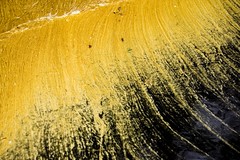
I came back home for 2 weeks in between work at the mine, to see family and partake in a 5 day canoe trip to Algonquin Park with Dan. We were dropped off at entrance 3 - Magnetewan Lake, and paddled a very roundabout route down to entrance 5 - Canoe Lake. Wildlife encounters included 5 moose, 2 islands full of nesting seagulls, a deer, dozens of loons, and large quantities of blackflies and mosquitos. We planned our route around maximizing creek / wetland travel, because they are more tranquil as well as more scenic than lakes.
Three historical sites were visited: the first lacking a description on the map and all we found were moose antlers, rusty metal artifacts, and strange stone cairns scattered at random throughout the underbrush. The second was a depot farm for logging camp supplies, which had some dilapidated wooden buildings and more rusty artifacts. The last historical site was a wilderness resort operated by the CNR from 1913 to 1937. All that remains are 4 large stone chimneys with no evidence of a building ever having been there. Oh, and lots of rusty artifacts. All these historical sites have one thing in common - there's always metal wreckage scattered about as if something exploded. We also saw Tom Thomson's lighthouse, but I won't count that as a real historical site.
Click the thumbnail above for my photos, brought to you by Flickr.
